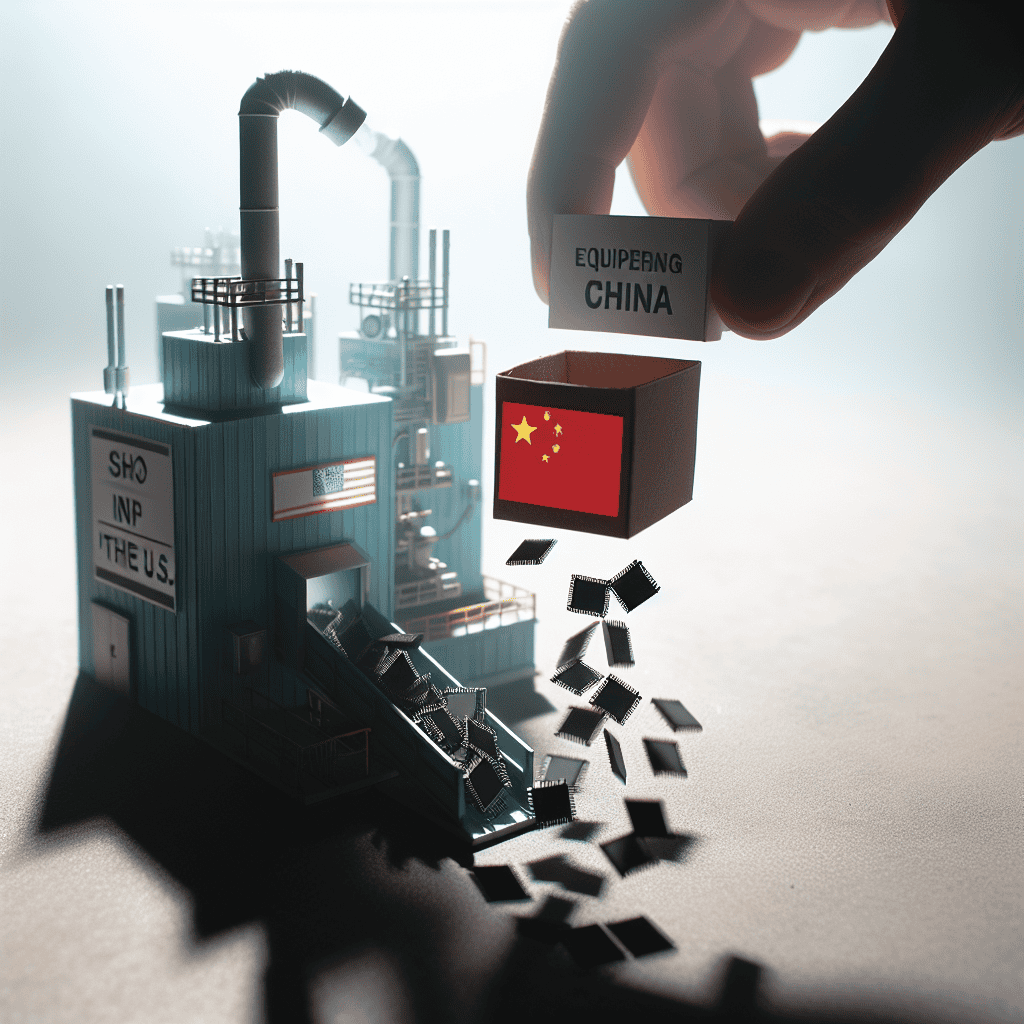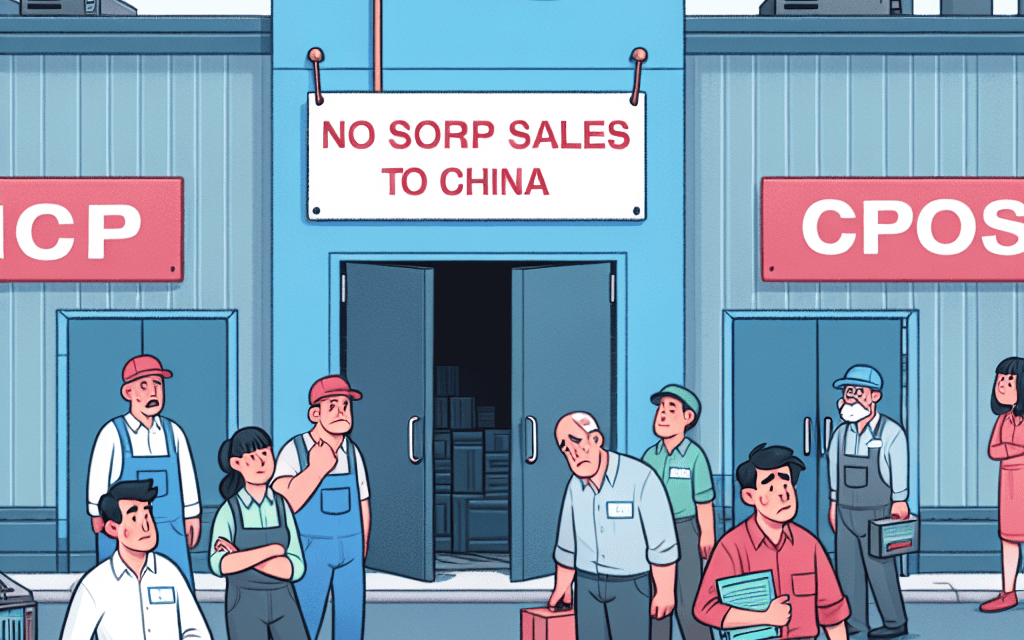“Tech Tensions Rise: U.S. Chip Equipment Sales to China Suspended”
Introduction
In a significant development impacting the global semiconductor industry, U.S. chip equipment manufacturers have announced a halt in sales to China. This decision comes amid escalating geopolitical tensions and increasing regulatory scrutiny over technology transfers between the two economic superpowers. The move is expected to have far-reaching implications for both the U.S. and Chinese tech sectors, potentially disrupting supply chains and affecting the production capabilities of Chinese semiconductor firms. As the U.S. government intensifies its efforts to curb China’s access to advanced technology, this halt in sales underscores the growing complexities and challenges in the international tech landscape.
Impact of U.S. Chip Equipment Sales Halt on Global Supply Chains
The recent decision by U.S. chip equipment manufacturers to halt sales to China marks a significant turning point in the global semiconductor industry, with far-reaching implications for international supply chains. This move, driven by escalating geopolitical tensions and national security concerns, underscores the intricate interdependencies that characterize the modern technological landscape. As the U.S. government tightens export controls on semiconductor technology, the ripple effects are poised to reshape the dynamics of global trade and innovation.
To begin with, the semiconductor industry is a cornerstone of modern technology, powering everything from smartphones to advanced computing systems. The halt in sales to China, a major player in the global semiconductor market, is likely to disrupt the delicate balance of supply and demand. China, which has been heavily investing in its semiconductor capabilities, relies significantly on U.S. equipment to advance its technological infrastructure. Consequently, the restriction on sales could impede China’s progress in achieving self-sufficiency in chip manufacturing, thereby affecting its broader economic ambitions.
Moreover, the impact of this decision extends beyond China, influencing global supply chains that are already under strain from various factors, including the COVID-19 pandemic and geopolitical uncertainties. Semiconductor manufacturing is a complex process that involves multiple stages and a diverse array of suppliers across different countries. The halt in sales could lead to bottlenecks in production, as Chinese manufacturers scramble to find alternative sources for the sophisticated equipment they require. This, in turn, could lead to delays and increased costs for companies worldwide that depend on Chinese semiconductors for their products.
In addition to affecting supply chains, the halt in sales is likely to accelerate the ongoing technological decoupling between the U.S. and China. As both nations vie for technological supremacy, the restriction on chip equipment sales could prompt China to intensify its efforts to develop indigenous technologies. This drive for self-reliance may lead to increased investment in research and development, as well as strategic partnerships with other countries that are not subject to U.S. export controls. While this could foster innovation and diversification in the global semiconductor industry, it also raises the specter of a fragmented technological ecosystem, with distinct standards and systems emerging in different regions.
Furthermore, the decision by U.S. manufacturers to halt sales to China could have significant economic implications for the companies themselves. The Chinese market represents a substantial portion of their revenue, and the loss of access could impact their financial performance. To mitigate these effects, U.S. companies may need to explore new markets or diversify their product offerings. However, this transition is unlikely to be seamless, given the specialized nature of semiconductor equipment and the competitive landscape of the industry.
In conclusion, the halt in sales of U.S. chip equipment to China is a development with profound implications for global supply chains and the semiconductor industry at large. As the world navigates this new reality, companies and governments alike must grapple with the challenges and opportunities that arise from shifting geopolitical dynamics. The path forward will require strategic foresight, collaboration, and adaptability to ensure that the global technology ecosystem remains resilient and innovative in the face of evolving circumstances.
The Role of U.S. Chip Equipment Manufacturers in the Semiconductor Industry
The semiconductor industry is a cornerstone of modern technology, underpinning everything from smartphones to advanced computing systems. Within this vast ecosystem, U.S. chip equipment manufacturers play a pivotal role, providing the sophisticated machinery necessary for the production of semiconductor chips. These manufacturers are integral to the global supply chain, offering cutting-edge technology that enables chipmakers to produce increasingly complex and efficient semiconductors. However, recent developments have seen U.S. chip equipment manufacturers halting sales to China, a move that has significant implications for the industry.
To understand the impact of this decision, it is essential to recognize the critical role that U.S. manufacturers play in the semiconductor industry. Companies such as Applied Materials, Lam Research, and KLA Corporation are leaders in the field, supplying essential equipment used in the fabrication of semiconductor wafers. Their technologies are crucial for processes such as etching, deposition, and inspection, which are fundamental to chip production. Consequently, any disruption in the availability of this equipment can have far-reaching effects on the global semiconductor supply chain.
The decision to halt sales to China is primarily driven by geopolitical tensions and national security concerns. The U.S. government has expressed apprehensions about the potential for advanced semiconductor technology to be used in military applications by foreign adversaries. As a result, export controls have been tightened, restricting the sale of certain high-tech equipment to Chinese companies. This move is part of a broader strategy to maintain technological superiority and protect sensitive technologies from falling into the hands of potential rivals.
The implications of this decision are multifaceted. On one hand, it poses challenges for Chinese semiconductor manufacturers, who rely heavily on U.S. equipment to maintain and expand their production capabilities. Without access to the latest technology, these companies may face difficulties in keeping pace with global competitors, potentially slowing the growth of China’s semiconductor industry. This could have a ripple effect on the global market, as China is a major player in the production and consumption of semiconductors.
On the other hand, U.S. chip equipment manufacturers may also experience repercussions. China represents a significant market for these companies, and the loss of sales could impact their revenue and growth prospects. However, it is worth noting that these manufacturers are likely to seek alternative markets and customers to mitigate the impact of reduced sales to China. Additionally, the U.S. government may provide support to these companies to help them navigate the challenges posed by the new export controls.
In conclusion, the halt in sales of chip equipment to China by U.S. manufacturers underscores the complex interplay between technology, geopolitics, and economics. While the decision is rooted in national security concerns, it has significant implications for the semiconductor industry as a whole. As the situation continues to evolve, stakeholders across the industry will need to adapt to the changing landscape, exploring new opportunities and strategies to ensure continued growth and innovation. The role of U.S. chip equipment manufacturers remains crucial, and their ability to navigate these challenges will be instrumental in shaping the future of the global semiconductor industry.
Geopolitical Implications of U.S. Trade Restrictions on China
The recent decision by U.S. chip equipment manufacturers to halt sales to China marks a significant development in the ongoing technological and geopolitical rivalry between the two global superpowers. This move, driven by escalating trade restrictions, underscores the complex interplay between national security concerns and economic interests. As the United States seeks to maintain its technological edge, the implications of these restrictions extend far beyond the immediate economic impact, influencing global supply chains, international relations, and the future of technological innovation.
To understand the broader geopolitical implications, it is essential to consider the context in which these trade restrictions have been implemented. The U.S. government has increasingly viewed China’s technological advancements, particularly in the semiconductor industry, as a potential threat to national security. Semiconductors are the backbone of modern technology, powering everything from smartphones to advanced military systems. By restricting the sale of chip-making equipment to China, the U.S. aims to curb China’s ability to produce advanced semiconductors, thereby limiting its technological and military capabilities.
However, this strategy is not without its challenges. The global semiconductor supply chain is highly interconnected, with components and expertise sourced from multiple countries. By restricting sales to China, U.S. manufacturers risk disrupting this delicate balance, potentially leading to supply chain bottlenecks and increased costs for companies worldwide. Moreover, these restrictions could incentivize China to accelerate its efforts to develop a self-sufficient semiconductor industry, potentially reducing its reliance on U.S. technology in the long term.
In addition to economic considerations, the halt in sales has significant diplomatic ramifications. The U.S.-China relationship is already fraught with tension, and these trade restrictions are likely to exacerbate existing frictions. China has consistently criticized U.S. trade policies as protectionist and has vowed to take countermeasures in response. This tit-for-tat dynamic could lead to a further deterioration of bilateral relations, complicating efforts to address other critical issues such as climate change and global health.
Furthermore, the decision by U.S. chip equipment manufacturers to halt sales to China may influence the strategic calculations of other countries. Allies and partners of the United States may find themselves caught in the crossfire, forced to navigate the competing demands of maintaining strong economic ties with both the U.S. and China. This could lead to a realignment of global alliances, as countries reassess their positions in light of the shifting geopolitical landscape.
Despite these challenges, the U.S. government remains steadfast in its commitment to protecting its technological interests. By restricting sales to China, the U.S. aims to preserve its competitive advantage in the semiconductor industry, which is crucial for both economic prosperity and national security. However, achieving this goal will require careful management of the complex web of economic, diplomatic, and strategic factors at play.
In conclusion, the halt in sales by U.S. chip equipment manufacturers to China is a pivotal moment in the broader context of U.S.-China relations. While the immediate impact is felt in the semiconductor industry, the long-term implications are far-reaching, affecting global supply chains, international diplomacy, and the future trajectory of technological innovation. As the world watches closely, the decisions made by both the U.S. and China in response to these trade restrictions will shape the geopolitical landscape for years to come.
How U.S. Chip Equipment Manufacturers are Adapting to New Trade Policies

In recent months, U.S. chip equipment manufacturers have faced significant challenges as they navigate the complexities of new trade policies that restrict sales to China. These policies, primarily driven by national security concerns, have prompted a reevaluation of business strategies among American companies that supply essential machinery for semiconductor production. As the global semiconductor industry is highly interconnected, the implications of these restrictions are profound, affecting not only the companies directly involved but also the broader technological landscape.
The U.S. government’s decision to impose these restrictions is rooted in the desire to curb China’s technological advancements, particularly in areas deemed critical to national security. By limiting China’s access to advanced chip-making equipment, the U.S. aims to maintain its competitive edge in the semiconductor industry. However, this move has forced American manufacturers to adapt swiftly to the changing regulatory environment. Companies such as Applied Materials, Lam Research, and KLA Corporation, which are leaders in the production of semiconductor manufacturing equipment, have had to reassess their market strategies and explore alternative avenues for growth.
One of the primary adaptations involves diversifying their customer base. With China being a significant market for these companies, the restrictions necessitate a shift in focus towards other regions. This includes increasing sales efforts in countries like South Korea, Taiwan, and Japan, which are also major players in the semiconductor industry. By strengthening relationships with these nations, U.S. manufacturers aim to mitigate the impact of lost sales to China. Additionally, there is a growing emphasis on expanding into emerging markets where semiconductor demand is on the rise, such as India and Southeast Asia.
Moreover, U.S. chip equipment manufacturers are investing heavily in research and development to maintain their technological leadership. By innovating and developing cutting-edge technologies, these companies can offer more advanced and efficient equipment, thereby attracting a broader range of customers. This focus on innovation not only helps in retaining existing clients but also in capturing new market segments that prioritize technological superiority.
Furthermore, collaboration with domestic and international partners has become a crucial strategy. By forming alliances with other technology firms and research institutions, U.S. manufacturers can leverage shared expertise and resources to accelerate innovation and enhance their product offerings. These partnerships also facilitate access to new markets and customer bases, providing a buffer against the financial impact of restricted sales to China.
In addition to these strategic shifts, U.S. chip equipment manufacturers are actively engaging with policymakers to navigate the regulatory landscape. By maintaining open lines of communication with government officials, these companies aim to influence future trade policies and ensure that their interests are considered in the decision-making process. This proactive approach is essential for adapting to an ever-evolving geopolitical environment.
In conclusion, the halt in sales to China has compelled U.S. chip equipment manufacturers to adapt in several ways. By diversifying their customer base, investing in research and development, forming strategic partnerships, and engaging with policymakers, these companies are working to overcome the challenges posed by new trade policies. While the road ahead is fraught with uncertainty, the resilience and adaptability of these manufacturers will play a crucial role in shaping the future of the semiconductor industry. As they continue to navigate this complex landscape, their efforts will not only determine their own success but also influence the global technological ecosystem.
The Future of Semiconductor Innovation Amid U.S.-China Trade Tensions
The recent decision by U.S. chip equipment manufacturers to halt sales to China marks a significant development in the ongoing trade tensions between the two global superpowers. This move, driven by escalating geopolitical concerns and national security considerations, has profound implications for the future of semiconductor innovation. As the semiconductor industry is a cornerstone of modern technology, the ripple effects of this decision are likely to be felt across various sectors, from consumer electronics to advanced computing and artificial intelligence.
To understand the broader impact, it is essential to consider the strategic importance of semiconductors. These tiny chips are the brains behind a multitude of devices, enabling everything from smartphones to sophisticated military systems. The U.S. has long been a leader in semiconductor technology, with its companies at the forefront of innovation and production. However, China has been rapidly advancing its capabilities, investing heavily in domestic semiconductor manufacturing to reduce its reliance on foreign technology. This ambition has been met with increasing scrutiny from the U.S., which views China’s technological rise as a potential threat to its own economic and national security interests.
The decision to halt sales of chip-making equipment to China is part of a broader strategy by the U.S. to curb China’s technological advancements. By restricting access to critical manufacturing tools, the U.S. aims to slow down China’s progress in developing cutting-edge semiconductor technologies. This move is not without precedent; it follows a series of export controls and sanctions targeting Chinese tech companies, most notably Huawei. These measures are designed to limit China’s ability to produce advanced chips that could be used in military applications or to gain a competitive edge in the global tech market.
However, the implications of this decision extend beyond the immediate U.S.-China dynamic. For one, it raises questions about the future of global supply chains. The semiconductor industry is highly interconnected, with components and expertise flowing across borders. Disruptions in this network could lead to increased costs and delays in production, affecting industries worldwide. Moreover, the halt in sales could incentivize China to accelerate its efforts to achieve self-sufficiency in semiconductor manufacturing, potentially leading to a bifurcation of the global tech ecosystem.
Furthermore, this development could spur innovation in unexpected ways. As Chinese companies face restrictions on accessing U.S. technology, they may seek alternative solutions, fostering innovation and competition in the global market. This could lead to the emergence of new players and technologies, reshaping the landscape of the semiconductor industry. At the same time, U.S. companies may need to explore new markets and partnerships to offset the loss of Chinese business, potentially driving innovation and collaboration in other regions.
In conclusion, the decision by U.S. chip equipment manufacturers to halt sales to China is a pivotal moment in the ongoing trade tensions between the two nations. While it aims to protect U.S. interests and maintain a technological edge, it also poses challenges and opportunities for the global semiconductor industry. As the world navigates this complex landscape, the future of semiconductor innovation will likely be shaped by the interplay of geopolitical forces, market dynamics, and technological advancements. The coming years will be crucial in determining how these factors converge to influence the trajectory of this vital industry.
Economic Consequences for U.S. Chip Equipment Manufacturers Halting Sales to China
The recent decision by U.S. chip equipment manufacturers to halt sales to China marks a significant shift in the global semiconductor landscape, with far-reaching economic consequences. This move, driven by escalating geopolitical tensions and regulatory pressures, underscores the intricate interdependence between the U.S. and Chinese technology sectors. As the world’s largest consumer of semiconductor equipment, China has been a crucial market for American manufacturers. The cessation of sales not only disrupts this symbiotic relationship but also poses substantial challenges for U.S. companies seeking to maintain their competitive edge in a rapidly evolving industry.
To begin with, the immediate impact on U.S. chip equipment manufacturers is a potential decline in revenue. China, being a major player in the semiconductor industry, has consistently been a top destination for American chip-making tools. The halt in sales could lead to a significant reduction in orders, thereby affecting the financial performance of these companies. This is particularly concerning for firms that have heavily invested in expanding their operations to cater to the Chinese market. Consequently, they may face the daunting task of reallocating resources and finding alternative markets to offset the loss of Chinese business.
Moreover, the decision to halt sales could have broader implications for the global semiconductor supply chain. The semiconductor industry is characterized by its complex and interconnected supply networks, where disruptions in one region can have cascading effects worldwide. By restricting sales to China, U.S. manufacturers may inadvertently contribute to supply chain bottlenecks, exacerbating the existing global chip shortage. This could lead to increased production costs and delays for companies reliant on these critical components, ultimately affecting a wide range of industries, from automotive to consumer electronics.
In addition to the immediate economic repercussions, the halt in sales may also have long-term strategic implications for U.S. chip equipment manufacturers. As China accelerates its efforts to achieve self-sufficiency in semiconductor production, American companies risk losing their technological edge. The Chinese government has been investing heavily in developing its domestic semiconductor capabilities, and the absence of U.S. equipment could serve as a catalyst for further innovation and growth within China’s own industry. This shift could potentially diminish the global influence of U.S. manufacturers, as Chinese firms become more competitive and self-reliant.
Furthermore, the decision to halt sales may strain diplomatic relations between the U.S. and China, with potential repercussions for other sectors of the economy. Trade tensions between the two nations have been a persistent issue, and this latest development could exacerbate existing frictions. As both countries navigate this complex geopolitical landscape, there is a risk of retaliatory measures that could impact other industries and further complicate international trade dynamics.
In conclusion, the decision by U.S. chip equipment manufacturers to halt sales to China presents a multifaceted challenge with significant economic consequences. While the immediate impact is likely to be felt in terms of reduced revenue and potential supply chain disruptions, the long-term implications could reshape the global semiconductor industry. As U.S. companies grapple with these challenges, they must strategically navigate this new landscape to maintain their competitive position and adapt to the evolving geopolitical environment. The outcome of this decision will not only influence the future of U.S.-China relations but also the broader trajectory of the global technology sector.
Exploring Alternative Markets for U.S. Chip Equipment Manufacturers
The recent decision by U.S. chip equipment manufacturers to halt sales to China marks a significant shift in the global semiconductor landscape. This move, driven by escalating geopolitical tensions and regulatory constraints, has prompted these companies to explore alternative markets to sustain their growth and maintain their competitive edge. As the semiconductor industry is pivotal to technological advancement and economic development, the implications of this decision are profound, necessitating a strategic pivot to new opportunities.
To begin with, the U.S. government’s restrictions on exporting advanced chip-making technology to China aim to curb the latter’s technological and military advancements. Consequently, U.S. chip equipment manufacturers, which have long relied on China as a major market, are compelled to reassess their strategies. This shift necessitates identifying and penetrating alternative markets that can absorb the potential shortfall in revenue. In this context, regions such as Southeast Asia, Europe, and India emerge as promising candidates due to their burgeoning tech industries and increasing demand for semiconductor technology.
Southeast Asia, with its rapidly growing economies and expanding digital infrastructure, presents a viable market for U.S. chip equipment manufacturers. Countries like Vietnam, Malaysia, and Thailand are investing heavily in their semiconductor sectors, driven by the global digital transformation and the need for advanced technology. By capitalizing on these developments, U.S. companies can establish a strong foothold in the region, leveraging local partnerships and government incentives to facilitate market entry and expansion.
Similarly, Europe offers substantial opportunities for U.S. chip equipment manufacturers. The European Union’s commitment to enhancing its semiconductor capabilities, as outlined in the European Chips Act, underscores the region’s strategic importance. By aligning with European initiatives to bolster semiconductor production and innovation, U.S. companies can tap into a market that values technological collaboration and sustainability. Furthermore, Europe’s emphasis on reducing dependency on non-European technology aligns with the interests of U.S. manufacturers seeking to diversify their market presence.
India, with its vast pool of skilled talent and a burgeoning tech ecosystem, also represents a promising market for U.S. chip equipment manufacturers. The Indian government’s initiatives to boost domestic semiconductor manufacturing, coupled with its ambition to become a global electronics hub, create a conducive environment for U.S. companies to invest and expand. By forging strategic alliances with Indian firms and leveraging the country’s cost advantages, U.S. manufacturers can not only mitigate the impact of lost sales to China but also contribute to India’s technological advancement.
In addition to exploring new geographical markets, U.S. chip equipment manufacturers are also focusing on diversifying their product offerings and enhancing their technological capabilities. By investing in research and development, these companies aim to innovate and create cutting-edge solutions that cater to the evolving needs of the global semiconductor industry. This approach not only strengthens their competitive position but also ensures long-term sustainability in a rapidly changing market landscape.
In conclusion, the halt in sales to China by U.S. chip equipment manufacturers necessitates a strategic realignment towards alternative markets. By capitalizing on opportunities in Southeast Asia, Europe, and India, and by fostering innovation and collaboration, these companies can navigate the challenges posed by geopolitical tensions and regulatory constraints. As the semiconductor industry continues to evolve, the ability to adapt and explore new avenues will be crucial for U.S. manufacturers to maintain their leadership and drive future growth.
Q&A
1. **What prompted U.S. chip equipment manufacturers to halt sales to China?**
The U.S. government imposed export restrictions to prevent advanced technology from being used by the Chinese military.
2. **Which companies are affected by the halt in sales to China?**
Major U.S. companies like Applied Materials, Lam Research, and KLA Corporation are affected.
3. **What types of equipment are restricted from being sold to China?**
Equipment used in the production of advanced semiconductors, particularly those below a certain nanometer threshold.
4. **How has China responded to these restrictions?**
China has criticized the restrictions, calling them unfair and a threat to global supply chains, and is seeking to boost its domestic semiconductor industry.
5. **What impact do these restrictions have on the global semiconductor industry?**
The restrictions could lead to supply chain disruptions, increased costs, and a push for technological self-sufficiency in China.
6. **Are there any exceptions to the sales restrictions?**
Some exceptions may exist for specific products or companies, but they typically require special licenses or approvals.
7. **What are the potential long-term effects of these restrictions on U.S. companies?**
U.S. companies may face revenue losses, reduced market share in China, and increased competition from non-U.S. firms.
Conclusion
The decision by U.S. chip equipment manufacturers to halt sales to China marks a significant escalation in the ongoing technological and trade tensions between the two countries. This move is likely driven by U.S. government policies aimed at restricting China’s access to advanced semiconductor technologies, which are critical for both commercial and military applications. The halt in sales could have substantial implications for the global semiconductor supply chain, potentially disrupting production and innovation in China while also affecting the revenue streams of U.S. companies. In the long term, this action may accelerate China’s efforts to develop its own semiconductor manufacturing capabilities, thereby reducing its reliance on foreign technology. Additionally, the decision could further strain U.S.-China relations, impacting broader economic and geopolitical dynamics.





